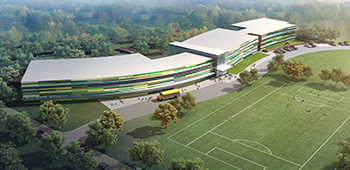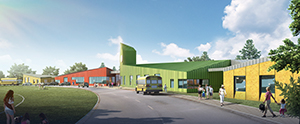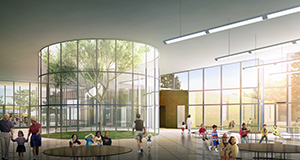Stillwater Schools Design for Singularity
 A magnetic use of color and the incorporation of the serene natural surroundings have created two singular designs for the children of Stillwater Public Schools.
A magnetic use of color and the incorporation of the serene natural surroundings have created two singular designs for the children of Stillwater Public Schools.
Will Rogers Elementary School and Highland Park Elementary School, both located in Stillwater, Okla., have been designed to create an aesthetic of joy and provide a sustainability method of high functionality and educational value within the project budget. Designed through a partnership between Selser Schaefer Architects, based in Tulsa, Okla., and Chicago-based Ross Barney Architects Inc., the school district sought to create two out-of-the-box designs to fit the needs of each microcommunity.
“We want the building to be able to explain why and how it’s been designed, how it fits into the environment and to be understood by the learners,” said Carol Ross Barney, FAIA, founder and principal at Ross Barney Architects. “We strive for that in every project.”
Charged to create a 3-D, sustainable design in order to educate attending students, the suburban Will Rogers Elementary will be seeking LEED Gold certification while Highland Park will attempt for LEED Silver. With the two significantly distinctive sites, the architects designed the schools to mirror each school’s landscape, Ross Barney said, but used similar techniques in attaining their respective certifications.
“The school board asked for the buildings to be unique and create inspirational vehicles of education,” said Robert Schaefer, AIA, principal at Selser Schaefer Architects.
Will Rogers Elementary
 Mimicking the path of the bordering creek, the two-story Will Rogers Elementary School used ribbon windows and composite panels in an array of green hues to craft a fluid, waving effect. Greens were used intentionally to remind occupants of the site’s surrounding trees and flow of water.
Mimicking the path of the bordering creek, the two-story Will Rogers Elementary School used ribbon windows and composite panels in an array of green hues to craft a fluid, waving effect. Greens were used intentionally to remind occupants of the site’s surrounding trees and flow of water.
“The way the school follows that meandering creek is absolutely the most unique thing about it,” Schaefer said. “It stops you and makes you look.”
When viewing the school from the second story on the north side of the building, one feels as if they’re in a tree house, Schaefer said. Each stairwell has a view to the outer surroundings, and this same link to the environment is emulated throughout the school.
“When you’re on the ground floor it’s just a natural projection to the outdoors and vice versa because the school is very transparent,” Schaefer said.
The 92,000-square-foot building is flooded with natural daylight via a glazed double height lobby, and views provide an even better organic connection to the surrounding site of gigantic elm trees, some measuring 48 inches in diameter. The creek, another influential element of the design, will be maintained for stormwater control.
“The connection to the landscape was really intentional and really important, both from a storytelling aspect to actual views,” Ross Barney said.
The $17.4 million school will serve approximately 600 pre-kindergarten to fifth-grade students. The lobby and welcome center is essentially placed between two gardens with the north and south exterior plazas serving as gathering spaces, student planting areas and outdoor classrooms.
 Situated on a 12-acre lot in a residential suburban neighborhood, the new school is being constructed next to the current school, which is also in close proximity to the downtown area and Oklahoma State University. Some construction is taking place just a mere six feet away from the existing school, Schaefer said.
Situated on a 12-acre lot in a residential suburban neighborhood, the new school is being constructed next to the current school, which is also in close proximity to the downtown area and Oklahoma State University. Some construction is taking place just a mere six feet away from the existing school, Schaefer said.
“Developing a design that fit on the site that could be built while another school stayed in operation the entire time was probably the biggest challenge,” Schaefer said.
The school will be the first two-story elementary school in Stillwater and will retain 90 percent of the site as open space.
Highland Park Elementary School
The architects showcase a completely different direction in the design of the 92,000-square-foot, single-story Highland Park Elementary School. Designed to accommodate 700 students from pre-kindergarten to fifth grade, the $17.7 million school is characterized by several “school houses” constructed from a combination of colored brick and glazed brick, with each grade level inhabiting its own schoolhouse with its own unique coloring.
“They have the same form and same windows but they have all these great colors on the outside,” Schaefer said. “What that does is it sets the stage for a student to develop a real ownership in his or her part of that school.”
The site of Highland Park is twice the size of Will Rogers at 24 acres. It features two very distinct terrains typical of the Cross Timbers: The front entrance consists of a prairie-like landscape, and the area of the school most isolated from the road features several eastern cedar trees.
“Our idea was to really emphasize the difference between the prairie and the forest, which is really an important feature of the Oklahoma landscape,” Ross Barney said.
The designers accentuated the contrast by planting more trees and vegetation in the forested area of the site. Visitors enter through a prairie then travel through a grove of trees to enter the school.
The school contains two large courtyards for two age groups with vegetable and flower gardens and numerous outdoor classrooms. The school finds a common space in the core of the school, which contains the cafeteria, kitchen and gymnasium auditorium.
In the center of the common space is the visually striking “focus” tree, which is 30 inches in diameter and surrounded by a circular glass atrium.
“The focus tree was meant to recall the forested part of our city,” Ross Barney said. “It’s basically a giant terrarium inside the school.”
Without Prototypes
Ross Barney said she holds much admiration and respect for the Stillwater Public Schools district because they did not ask for a prototype, often believed to be the cheaper school construction choice, but instead required architects to delve into the needs of the specific sites and surroundings.
“What works on one site doesn’t necessarily work on another,” she said. “They aren’t equal solutions, in fact, they’re very unequal solutions if you use the same building everywhere.”
The mechanics of each school are very similar; both use a geothermal system, daylighting and provide visible representations and exposure of the schools’ commitment to sustainability. But by the use of color and incorporating the site, the designs have developed their own exclusive character.
“All the practical maintenance is very much the same and not unique,” Schaefer said. “But on the big scale and what you experience is very much unique for each school.”
According to Schaefer, Ross Barney is extremely gifted in incorporating a compelling use of color. The colors displayed in each of the new Stillwater schools create a joyful uniqueness to each school.
“We were asked to create a sense of delight and inspiration in the students, teachers and the community,” Schaefer said. “I think the color and its use sends this message to the community about how important education is.”
Will Rogers Elementary School was open for students in late October, while Highland Park Elementary School opened at the start of the school year in August. Lambert Construction Company of Stillwater, Okla., served as construction manager on both projects.
With their unique designs, Selser Schaefer and Ross Barney Architects hope to create singular educational experiences with an overwhelming sense of student ownership.
“We feel like these schools are [ones] children will remember for the rest of their lives and be proud of for the rest of their lives,” Schaefer said. “Schools should be the best environment that you experience as a young person, and these schools are going to give that.”
